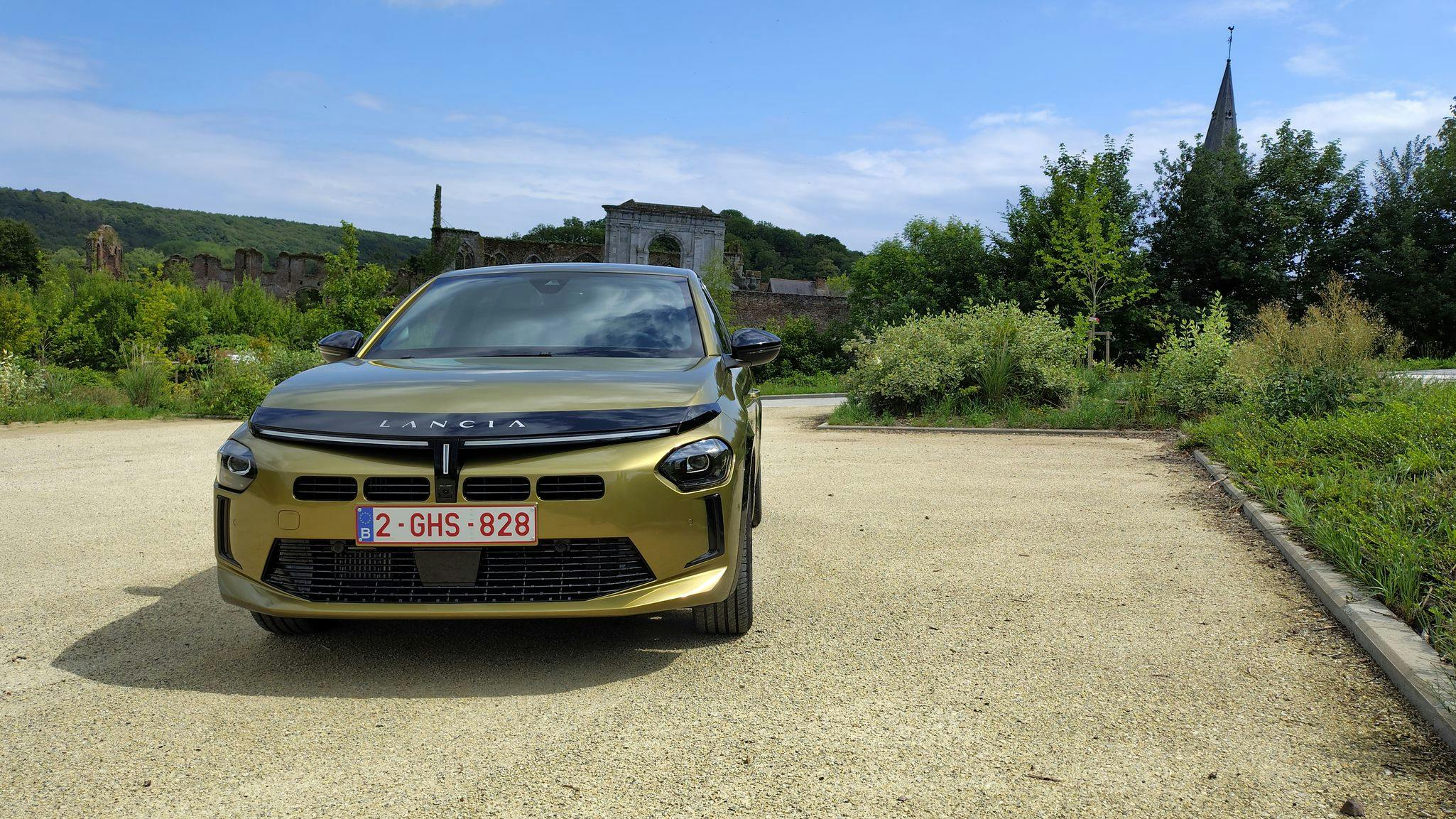
TAGTIK NEWS - TO THE POINT
The Lancia Ypsilon Ibrida plays its joker in style

Lancia's chic Italian city car began its career as an all-electric model. Now comes the "ibrida" version of the Ypsilon. A name that nevertheless hides a certain addiction to oil.

To begin with, let's be frank: the Lancia Ypsilon Ibrida is not a hybrid in the Prius sense of the term. It's a microhybrid MHEV with a small 0.432 kWh battery and a 48 V electric motor providing some boost. The Turin city car, Stellantis version, is based on the Peugeot 208. It is therefore also a cousin of the Opel Corsa. The Italian, however, has personality traits in terms of exterior design and interior layout. Frankly, the Ypsilon plays the card of originality and individuality. The tifosis will also recognize in the design of the rear lights certain references to the legendary Stratos. We thrill as we can.

Familiar Engine
Under the hood, we find the same engine: a 1.2-liter Puretech turbocharged gasoline engine with 100 hp (74 kW) coupled with a 21 kW (28 hp) electric motor for a combined output of 110 hp (81 kW). Transmission to the front wheels is managed by a 6-speed e-DCT dual-clutch automated transmission. A very important tidbit: this is the new version of the Puretech. Gone is the infamously brittle belt soaking in oil, but a timing chain instead.

On the road
Now that the technical presentation is over, it's time to get behind the wheel of the Ypsilon Ibrida. It starts with the button at the foot of the center console. The internal combustion engine roars to life. From the moment it starts, you'll notice that, despite the 46 hp difference in power compared to the electric version, the Ypsilon Ibrida isn't much lazier. However, it loses 1 second in the 0 to 100 km/h (9.3 s instead of 8.2 s). But a combustion engine has a different way of doing things. The city car makes no mistake about it. Especially since it has a significant advantage over its electric sibling: it weighs 300 kg less.

Its lightness is a perfect companion to its aesthetic grace. The Ypsilon Ibrida is less timid in the curves. Even if the steering lacks firmness in Normal mode. Moreover, this excessive flexibility somewhat curbs the ardor when taking manual control of the transmission via the paddles behind the steering wheel, after pressing the M button. It's better to first opt for the Sport driving mode. And there, the Italian car shows what its good chassis is made of. The body holds well with a firm suspension at the rear. There is more spring at the front. But with restraint and elegance.

Fascinating Palazzo
Speaking of elegance, the Lancia Ypsilon is clearly the most stylish of Stellantis' trio of B-segment city cars. Under the air conditioning control panel, there's a small round table. On it, there's space to place your smartphone for wireless charging. The colors of our test model also featured gold bling. The S.A.L.A. system is supposed to harmonize the ambiance with the driver's preferences, music, and climate control after saying "Hey Sala." It's prettier in tunnels and at night than during the day, when you can't really see the difference between the different lighting moods. However, to enjoy the music, you can count on good soundproofing throughout.

A nice presentation effort with the textured recycled velvet seats. A charming little touch to justify the premium character intended by the marketing. Because we're not in a Mini or an Audi. That said, we're not in a Peugeot, a Fiat, or an Opel either. It's chic, sure, but that doesn't hide some of the plastic on board. Furthermore, in summer, this soft upholstery retains a little too much heat. Watch out for your butt after parking in the sun!


Limited space
More prosaically, the Ypsilon has two 10.25" screens. One for infotainment, compatible with Apple Car Play and Android Auto, and the one behind the steering wheel for driving information. The latter lacks display customization options. In the rear, the legs of passengers seated on a somewhat hard seat – made of recycled velvet – will constantly remind themselves that we're in a "small" sedan measuring 4.08 m long and 1.44 m high. The roofline and small windows don't help the feeling of confinement. Yet, this car has a rather generous trunk for its size: 352 liters under the luggage cover, extending to 1,163 liters when the rear seats are folded down.

Back on the road
Before getting back behind the wheel, a (general) question arises. Why offer a keyless entry system and, as standard, require the use of a remote control to (un)lock the vehicle? You still have to take the key in hand... After a trip to the countryside, let's head into the city. In the city, micro-hybrid technology is a true ally. Engine vibrations regularly disappear to let the electricity do the work for a few moments. Afterward, the transition is sometimes harsh when the engine starts up again. The transmission sometimes lacks smoothness during gear changes, which are felt as slight jolts.

Not too fuel-hungry
By taking your right foot off the accelerator, the regenerative inertia allows you to slow down without having to constantly press the brake. All this allows you to make progress in built-up areas without excessive fuel consumption. Moreover, its size makes it easy to fit into traffic. And when it's time to park, it's not too difficult to find space. Even if, another bad Stellantis habit, the surround-view camera sometimes forgets to show part of the panorama! On the highway, the Lancia doesn't lack determination. The acceleration is decent for a car with a maximum power of 110 hp. Moreover, in this respect, it can travel much faster than the electric version. And, more importantly, for much longer. The average real-world fuel consumption of this Ypsilon was 5.5 l/100 km. Highway runs at 120 km/h even demonstrated, once again, that a combustion engine has no trouble remaining fuel-efficient on long stretches. The actual range between two fuel pump nozzles thus exceeds 700 km. By being economical, it is possible to exceed 800 km.

Financial Review
Basically, the Lancia Ypsilon is more expensive than its cousins. This makes sense: the Ypsilon doesn't have the 100 hp 1.2-liter engine without electrical assistance. That said, with the same 110 hp micro-hybrid engine, the Italian model is only slightly more expensive, costing €22,810 without options for the base trim (available in Belgium in July 2025). The version I tested had the LX trim and few options: colors, integrated navigation, and 17-inch Mondrian wheels. That's €29,750. That's still €1,000 cheaper than the Ypsilon Elettrica! But it's possible to add a few accessories and packages to exceed €30,000...

In France, prices start at €24,800. It will be impossible to have the same configuration as in Belgium; Mondrian rims, for example, are not offered. However, a Ypsilon Ibrida with similar equipment will cost at least €28,200. In Luxembourg, the basic price will be €22,052; and for a configuration similar to the model presented here: €26,750. Lancia is not yet distributed in Switzerland. In Italy, prices for the "Nuova Ypsilon Ibrida" start at €19,900. In the LX trim with the same equipment as in the Belgian catalog, you will have to pay €24,300. In the Netherlands, the Ypsilon Hybrid costs at least €30,800. You will have to pay €34,850 to find the Ypsilon Hybrid LX as illustrated here.

(MH with Olivier Duquesne – Source : Lancia – Stellantis – Photos : © Olivier Duquesne)

LATEST NEWS

Jafar Panahi Wins New York Award and is Sentenced to Prison by Iran

Born on December 2: Peter Kingsbery, founder of Cock Robin with firebrand Ana LaCazio

Born on December 1: Julee Cruise, "Twin Peaks'" haunting voice

Born on December 1st: Alain Bashung, French rock poet who waited a long time for success

Born on November 30: Billy Idol, the (kind) rebel of Generation X

Born on November 28: Randy Newman tells stories and makes movies
Quick links